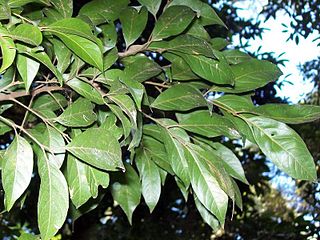
Alectryon is a genus of about 30 species of trees and shrubs from the family Sapindaceae. They grow naturally across Australasia, Papuasia, Melanesia, western Polynesia, east Malesia and Southeast Asia, including across mainland Australia, especially diverse in eastern Queensland and New South Wales, the Torres Strait Islands, New Guinea, the Solomon Islands, New Caledonia, New Zealand, Vanuatu, Fiji, Samoa, Hawaii, Indonesia and the Philippines. They grow in a wide variety of natural habitats, from rainforests, gallery forests and coastal forests to arid savannas and heaths.

Cupaniopsis is a genus of about 67 species of trees and shrubs of the soapberry family, Sapindaceae. They grow naturally in New Guinea, New Caledonia, Australia, Torres Strait Islands, Fiji, Samoa, Sulawesi, Micronesia. Many species have been threatened with extinction globally or nationally, with official recognition by the International Union for Conservation of Nature (IUCN) and several national and state governments.

Harpullia is a genus of about 27 species of small to medium-sized rainforest trees from the family Sapindaceae. They have a wide distribution ranging from India eastwards through Malesia, Papuasia and Australasia to the Pacific Islands. They grow naturally usually in or on the margins of rainforests or associated vegetation.

Arytera is a genus of about twenty–eight species known to science, of trees and shrubs and constituting part of the plant family Sapindaceae. They grow naturally in New Guinea, Indonesia, New Caledonia, Australia, the Solomon Islands, Vanuatu, Fiji, Samoa, Tonga; and the most widespread species and type species A. littoralis grows throughout Malesia and across Southeast Asia, from NE. India, southern China, Borneo, Malaysia, Singapore, Indonesia and the Philippines to as far east as New Guinea and the Solomon Islands.

Elattostachys is a genus of about 21 species of trees known to science, constituting part of the plant family Sapindaceae.

Glenniea is a genus of plant in the family Sapindaceae.
Placodiscus is a genus of plant in family Sapindaceae. The following species are accepted by Plants of the World Online:

Sarcopteryx is a genus of about 12 rainforest tree species known to science, of the plant family Sapindaceae. They occur in Australia, New Guinea and the Moluccas.
Thouinia is a genus of flowering plants in the family Sapindaceae. As of 2020 Kew's Plants of the World Online lists 27 species in the genus:

Sapindoideae is a subfamily of flowering plants in the soapberry family, Sapindaceae.
Tristira is a genus of flowering plants belonging to the family Sapindaceae.
Toulicia is a genus of flowering plants belonging to the family Sapindaceae.
Tripterodendron is a genus of flowering plants belonging to the family Sapindaceae.
Thinouia is a genus of flowering plants belonging to the family Sapindaceae.
Thouinidium is a genus of flowering plants belonging to the family Sapindaceae.
Aporrhiza is a genus of flowering plants belonging to the family Sapindaceae.
Chonopetalum is a genus of flowering plants belonging to the family Sapindaceae.
Chytranthus is a genus of flowering plants belonging to the family Sapindaceae.
Cladostigma is a genus of flowering plants belonging to the family Convolvulaceae.







